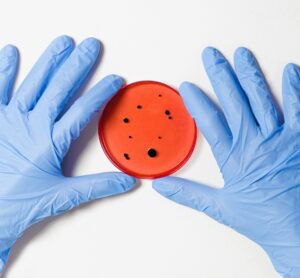Bacterial colonization and chronic airway infections are a common and serious problem for people with bronchiectasis and cystic fibrosis (CF). These infections can lead to frequent flare-ups (exacerbations), lead to accelerated loss of lung function, and make you feel tired, lack energy and generally feel under the weather. One of the most effective strategies for managing chronic lung infections is the use of inhaled antibiotics, which deliver medication directly to the lungs to combat persistent bacteria. When antibiotics are delivered directly to the lungs, it allows for a higher local drug concentration while minimizing systemic side effects. The intent is that maintenance with inhaled antibiotics will lead to you needing fewer courses of oral or even intravenous antibiotics. This approach can reduce the frequency and severity of exacerbations, improve lung function, and enhance overall well-being.
When using inhaled antibiotics, it is crucial to administer after you have completed your airway clearance session – you don’t want the drug to be deposited onto sputum that you will expel shortly afterward! Any inhaled drug can cause some chest tightness because it may irritate the airways – if this occurs use albuterol or levalbuterol approximately 15 minutes before the dose (inhaler or nebulized). If the tightness is severe, stop and consult your doctor.
Common side effects of all inhaled drugs:
- Sore throat
- Cough
- Change in voice
- Chest tightness (see above about pre-treating with a bronchodilator)
I want to expand on the four most common antibiotics that are prescribed: tobramycin, colistin, amikacin and aztreonam.
Tobramycin (Tobi® / Kitabis Pak® / Bethkis® / Tobi Podhaler®)
Tobramycin is commonly used to treat chronic Pseudomonas infections (and occasionally other resistant bacteria), in people with CF, bronchiectasis and chronic obstructive pulmonary disease (COPD). It is typically used at a dose of 300mg twice a day in a cyclical manner (28 days on, 28 days off) to prevent the drug building up in the body and reduce bacterial resistance. If you have kidney problems, your doctor should be aware as tobramycin can rarely irritate the kidneys. The most common side effects are cough, change in voice and sore throat. If you develop any of these symptoms, persevere for a few days as these symptoms may improve as your body gets used to the drug. Tobramycin can be delivered with your standard home nebulizer but do not mix with other drugs.
Clinical trials have demonstrated that inhaled tobramycin significantly improves lung function and reduces the frequency of exacerbations in patients with CF. It has also been shown to reduce the number of Pseudomonas bacteria in the lungs and long-term studies indicate that patients on a tobramycin regimen experience fewer hospitalizations and better respiratory outcomes. When it works, you will notice that your sputum volume is lower and you will need fewer coursesof antibiotics.
How to prepare
Tobramycin comes in three forms: (i) a capsule containing powder can be inhaled using the Podhaler device® – specifically for CF patients, (ii) a preservative free inhalation solution (Tobi®, Bethkis®, Kitabis Pak®) and (iii) a generic inhalation solution. In general we prefer to use preservative-free solutions (cost permitting).
– wash hands before use
– preservative free solutions do not require dilution. They can be transferred to the nebulizer cup and inhaled via a good nebulizer machine – Phillips or Pari (do not mix with other solutions).
– Generic tobramycin solution may need dilution with sterile water or normal saline to a volume of 8ml to minimize respiratory side effects.
– Use the nebulizer to inhale the medication immediately, making sure to breathe deeply and slowly.
– Clean the nebulizer after use to prevent contamination.
Colistin (Polymyxin E / Colistimethate sodium / Coly-Mycin M®)
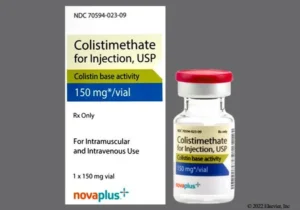
Colistin is primarily used to treat infections caused by multidrug-resistant Pseudomonas aeruginosa and other gram-negative bacteria. It is often prescribed when other antibiotics are no longer effective due to resistance or if you poorly tolerated inhaled tobramycin. The usual dose is 150mg twice a day (150mg is sometimes written as 4.5 million units).
Research has shown that inhaled colistin can reduce bacterial load in the lungs, decrease exacerbation frequency, and stabilize lung function in patients with chr
onic Pseudomonas infection. One study found that regular use of colistin in people with CF led to fewer hospitalizations and improved lung health over time.
How to prepare (do just prior to use)
Colistin usually comes in a powder form that must be reconstituted with sterile water or normal saline.
– Wash your hands thoroughly.
– Inject 4-5ml of sterile water or normal saline (you should have vials of this) into the colistin powder and agitate gently until all the powder is dissolved.
– Remove the cap and pour the solution into the nebulizer chamber.
– Use the nebulizer to inhale the medication immediately, making sure to breathe deeply and slowly.
– Clean the nebulizer after use to prevent contamination.
Aztreonam (Cayston®)
Aztreonam is used for treating chronic Pseudomonas infections, especially when patients have not responded well to other inhaled antibiotics like tobramycin. It is also used at a dose of 75mg three times a day in a cyclical fashion, similar to tobramycin, to manage bacterial resistance. The only downside to Cayston is that it has to be taken three times a day with doses being at least 4 hours apart. We usually recommend pre-treating with a bronchodilator to tolerate it.
How to prepare (do just prior to use)
Aztreonam is delivered using a specific nebulizer system (Altera® Nebulizer System) designed for this drug. Cayston is supplied from a few specialty pharmacies in a reconstituted
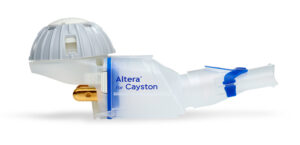
solution (IV Solutions/Maxor; Foundation Care; Pharmaceutical Specialties Inc; TLCRx/ModernHEALTH; and Walgreens Specialty Pharmacy)
– Wash your hands thoroughly.
– Transfer the solution to the Altera nebulizer chamber.
– Inhale the medication as directed, using deep, steady breaths.
– After treatment, clean the nebulizer carefully.
Amikacin (Arikayce®)
Amikacin is generally used for more difficult-to-treat infections, such as those caused by Mycobacterium avium complex (MAC), particularly in patients with bronchiectasis. It may be prescribed when other treatments have not been effective.
Prior studies on inhaled amikacin (especially Arikayce®, a liposomal formulation) show that it can help people clear MAC from the lungs and improve lung function and symptoms in patients with refractory MAC lung disease. Some patients also experience a decrease in exacerbation rates over time.
How to prepare
Amikacin is available as a viscous, liposomal formulation for inhalation, which requires specific nebulization through the Lamira eFlow® nebulizer system which is supplied with the drug.
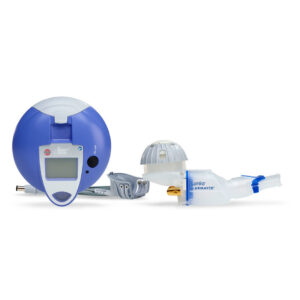
– Wash your hands before handling the medication.
– Prepare the Lamira eFlow® nebulizer according to the manufacturer instructions
– Shake the vial for 10-15 seconds prior to pouring it into the medication reservoir
– Inhale the medication over the prescribed time period.
– Clean the nebulizer after each use
Like many treatments in bronchiectasis and cystic fibrosis, inhaled antibiotics require time, dedication and diligence to help you stay healthy. Inhaled antibiotics, although inconvenient, are an important tool to help keep your lungs healthy and prevent you from needing recurrent courses of antibiotics. If you are ever in doubt about how you are supposed to be doing something reach out to your physician. Also do not get frustrated if you are told to do something explained above in a different way – there is not a 100% correct way to do this and doing it a slightly different way will likely not diminish its effect.
Stay well.
